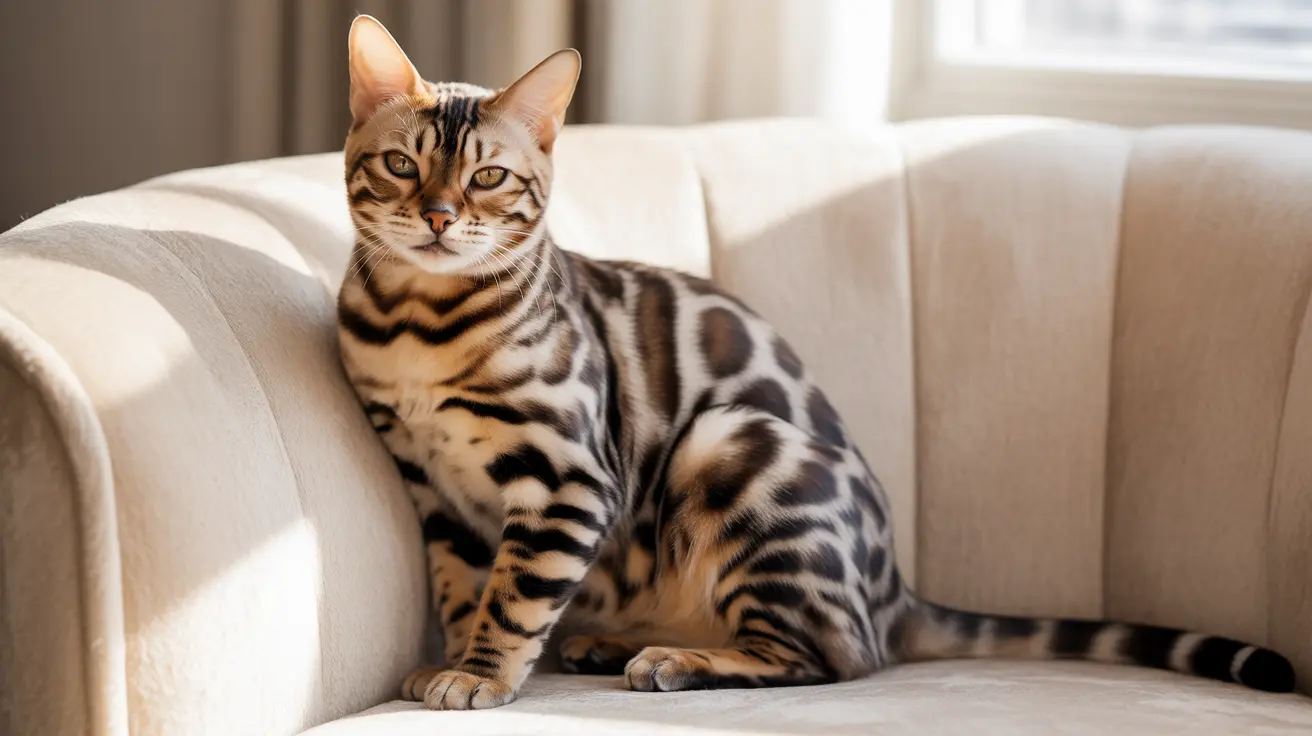Cat Body Language Signs of Annoyance: How to Read Your Feline's Mood
Understanding your cat's emotional state through their body language is one of the most valuable skills any cat owner can develop. Unlike dogs, cats communicate their feelings through subtle and sophisticated signals that require careful observation to decode properly. When your feline friend is feeling annoyed, grumpy, or simply wants to be left alone, they'll display specific cat body language signs of annoyance that serve as clear warnings before escalating to more aggressive behaviors.
Learning to recognize these early warning signals not only helps prevent scratches and bites but also strengthens the bond between you and your cat by showing respect for their boundaries. From tail positions and ear orientations to whisker movements and vocalizations, cats use their entire body as a communication system to express their current mood and intentions.
In this comprehensive guide, we'll explore the various ways cats express annoyance and irritation, helping you become fluent in feline body language so you can respond appropriately to your cat's needs and maintain a harmonious relationship.
The Cat's Tail: Your Feline's Primary Mood Indicator
The tail serves as perhaps the most reliable barometer of your cat's emotional state, acting as a visible indicator of everything from contentment to intense agitation. When cats are annoyed or irritated, their tail movements become more pronounced and agitated compared to their relaxed state.
A cat experiencing annoyance will often display rapid tail flicking or thrashing motions. This flicking can range from subtle twitches at the tip to vigorous side-to-side movements that involve the entire tail. The intensity of the movement typically correlates with the level of irritation your cat is feeling. While some tail flicking might indicate focused attention during hunting or play, persistent, aggressive tail movements in social situations clearly signal that your cat wants space.
When a cat feels particularly threatened or annoyed, you may observe their tail puffing up significantly, a phenomenon known as piloerection. This dramatic increase in tail size is an attempt to appear larger and more intimidating to whatever is causing their distress. Conversely, a tail held low or tucked between the legs indicates fear and submission, suggesting your cat is feeling overwhelmed and seeking to make themselves appear smaller and less threatening.
Ear Positions and What They Reveal About Annoyance
Cat ears are incredibly mobile and expressive, capable of rotating nearly 180 degrees to communicate different emotional states. Understanding ear positions is crucial for recognizing cat body language signs of annoyance before they escalate into more serious behavioral issues.
When cats begin to feel annoyed or agitated, their ears will often turn sideways, creating what many experts call "airplane ears" due to their horizontal positioning. This sideways ear position serves as an early warning sign that your cat is becoming uncomfortable with the current situation and may need space or a change in environment.
As annoyance intensifies, cat ears will flatten further back against their head, pressing close to their skull. This flattened ear position represents a defensive posture and indicates that your cat is feeling threatened and preparing for potential conflict. Ears pressed completely flat against the head signal maximum distress and readiness to defend themselves if necessary.
In contrast to these warning positions, relaxed and content cats maintain their ears in a forward-facing position, showing engagement and openness to interaction. Learning to distinguish between these positions helps you gauge when to approach your cat and when to give them the space they're requesting.
Whisker Movements and Their Significance
Whiskers provide another layer of communication that many cat owners overlook when interpreting their pet's mood. These sensitive facial features move in coordination with your cat's emotional state and can provide valuable insights into their level of comfort or annoyance.
When cats feel annoyed or threatened, they pull their whiskers back against their face, attempting to make themselves appear smaller and less noticeable. This backward whisker position often accompanies other defensive body language signals and indicates that your cat is feeling overwhelmed or anxious about their current situation.
Relaxed whiskers that hang naturally from your cat's face indicate contentment and ease, while whiskers pushed forward suggest curiosity or alertness. By observing whisker position alongside other body language cues, you can develop a more complete understanding of your cat's emotional state and respond appropriately to their needs.
Eye Signals: Windows to Your Cat's Emotional State
Cat eyes provide powerful insights into their emotional state, with pupil size and gaze patterns serving as reliable indicators of annoyance and agitation. Understanding these visual cues helps you recognize when your cat is becoming uncomfortable before they resort to more dramatic warning signals.
Pupil dilation in cats occurs for various reasons, but when combined with other signs of annoyance, very dilated pupils often indicate that your cat perceives a threat or feels highly agitated. Conversely, narrow pupils in low-light situations or when not caused by brightness changes typically signal anger or intense focus, particularly when accompanied by a direct, unwavering stare.
A prolonged, direct stare from an annoyed cat serves as a warning signal, communicating dominance or threat. This intense gaze differs significantly from the slow, deliberate blinking that relaxed cats use to show trust and affection. Learning to distinguish between these different eye communications helps you respond appropriately to your cat's current emotional needs.
Postural Changes That Signal Annoyance
Your cat's overall body posture provides crucial information about their comfort level and willingness to interact. Annoyed cats often display specific postural changes that serve as clear warnings before more aggressive behaviors emerge.
An arched back combined with raised fur represents one of the most dramatic signs of feline annoyance and fear. This posture, accompanied by piloerection, makes the cat appear larger and more intimidating to potential threats. The arched back posture signals that your cat feels cornered or threatened and is preparing to defend themselves if necessary.
Cats experiencing annoyance may also adopt a tense, crouched position with their body pulled into a tight ball. This defensive posture indicates anxiety and a desire to make themselves less visible while maintaining readiness to flee or fight if the situation escalates. A relaxed cat, in contrast, will stretch out comfortably or lie in exposed positions that demonstrate trust and security.
Vocal Warnings: Understanding Feline Vocalizations
While cats rely heavily on body language for communication, vocalizations provide additional context for understanding their emotional state. Annoyed cats produce specific sounds that serve as audible warnings alongside their physical displays of irritation.
Growling represents one of the clearest vocal indicators of annoyance and displeasure. This low, rumbling sound serves as a warning that your cat is feeling threatened and wants whatever is bothering them to stop immediately. Hissing escalates beyond growling, indicating that your cat feels cornered and is prepared to defend themselves aggressively.
Yowling and shrieking represent the most intense levels of vocal distress, often accompanied by defensive or aggressive postures. These loud vocalizations indicate maximum stress and should be taken seriously as warnings that your cat needs immediate relief from whatever is causing their distress.
How to Respond to an Annoyed Cat
Recognizing cat body language signs of annoyance is only valuable if you know how to respond appropriately to these signals. The key to maintaining a positive relationship with your cat lies in respecting their communication and adjusting your behavior accordingly.
When you notice early signs of annoyance such as tail flicking or sideways ears, the best response is to give your cat space and remove whatever stimulus might be causing their discomfort. Avoid the temptation to force interaction or attempt to calm them through petting, as this often escalates their stress level rather than providing comfort.
If your cat is displaying more intense signs of annoyance such as flattened ears, growling, or an arched back, it's crucial to back away slowly and avoid direct eye contact. Sudden movements or continued attempts at interaction can trigger defensive behaviors including scratching or biting. Instead, allow your cat time and space to calm down naturally before attempting any further interaction.
Environmental Factors and Stress Reduction
Understanding that environment significantly influences cat behavior helps you create conditions that minimize annoyance and stress. Cats feel more comfortable and secure in familiar, safe spaces with multiple escape routes and elevated perches where they can observe their surroundings.
Interactive play serves as an essential tool for preventing boredom and frustration that can lead to irritability. Regular play sessions help cats expend energy constructively and maintain mental stimulation, reducing the likelihood of developing chronic annoyance or behavioral problems.
Providing safe retreat areas such as cat towers, window perches, or quiet hiding spots allows your cat to remove themselves from stressful situations voluntarily. This environmental enrichment helps prevent the buildup of stress that often manifests as persistent annoyance or aggression.
When Annoyance May Indicate Health Issues
While occasional annoyance is normal feline behavior, persistent irritability or sudden changes in temperament may indicate underlying health problems that require veterinary attention. Cats often mask pain or illness, making behavioral changes one of the few visible indicators that something is wrong.
Chronic stress or anxiety in cats can manifest through excessive grooming, hiding, changes in eating or toileting habits, and altered vocal patterns. If your typically calm cat suddenly becomes persistently annoyed or aggressive, or if their body language consistently signals distress, a veterinary examination can help rule out medical causes for their behavioral changes.
Pain-related annoyance often presents differently than situational irritation, with cats showing sensitivity to touch in specific areas or displaying consistent defensive postures even in comfortable environments. Early detection of these health-related behavioral changes can lead to more effective treatment and improved quality of life for your feline companion.
Frequently Asked Questions
How quickly can a cat's body language change from calm to annoyed?
Cat body language can change within seconds, particularly when they encounter unexpected stimuli or feel threatened. The tail is often the first indicator, with flicking or twitching beginning almost immediately when annoyance starts, followed by ear position changes and other warning signals.
Is it safe to pet a cat showing mild signs of annoyance like slight tail flicking?
It's best to avoid petting a cat displaying any signs of annoyance, even mild ones like tail flicking. These early warning signals indicate your cat needs space, and continued interaction often escalates their stress level and may lead to more defensive behaviors.
Can some cats naturally appear more annoyed than others due to their facial structure?
While facial structure doesn't change the actual body language signals, some breeds with flatter faces or certain ear shapes may appear more intense. However, the fundamental movements and positions that indicate annoyance remain consistent across all cats regardless of breed or appearance.
How long should I wait before approaching a cat that showed signs of annoyance?
Allow your cat to return to relaxed body language before attempting interaction. This typically takes anywhere from a few minutes to several hours, depending on what caused their annoyance and your cat's individual temperament. Look for forward-facing ears, relaxed whiskers, and calm tail position as indicators they're ready for interaction again.
Do indoor cats show different signs of annoyance than outdoor cats?
The basic body language signals remain the same, but indoor cats may show annoyance more frequently due to limited escape routes and constant human presence. They might also develop different triggers for annoyance based on their controlled environment, such as changes in routine or household disruptions.
Can kittens show the same signs of annoyance as adult cats?
Kittens display many of the same body language signals as adults, though their responses may be less intense or persistent. Young cats are still learning social boundaries and may show annoyance more quickly but also recover faster than mature cats who have established stronger behavioral patterns.
Should I be concerned if my cat's ears are frequently positioned sideways?
Frequent sideways ear positioning suggests your cat is experiencing ongoing stress or discomfort. This could indicate environmental issues, health problems, or chronic anxiety that may benefit from veterinary evaluation and environmental modifications to reduce stress triggers.
Conclusion
Mastering the art of reading cat body language signs of annoyance transforms your relationship with your feline companion from reactive to proactive. By learning to recognize the subtle signals cats use to communicate their emotional state, you can respond appropriately to their needs and prevent minor irritation from escalating into serious behavioral problems.
Remember that each cat is an individual with their own personality and communication style, but the fundamental body language signals remain consistent across the species. Regular observation and respectful response to your cat's signals not only prevents conflicts but also builds trust and strengthens your bond. When in doubt about persistent behavioral changes or signs of distress, consulting with your veterinarian ensures your cat's physical and emotional well-being remains optimal.






